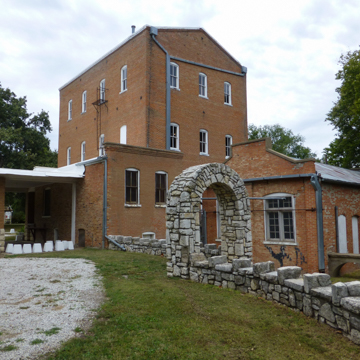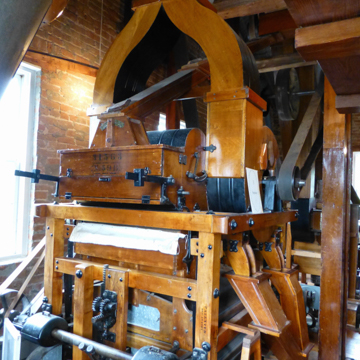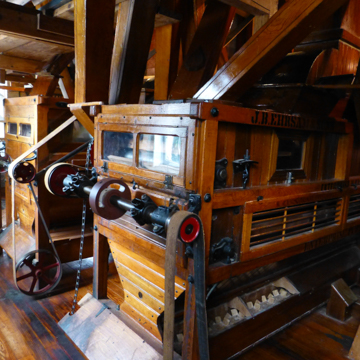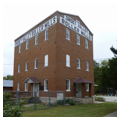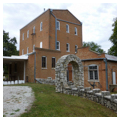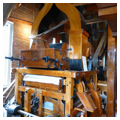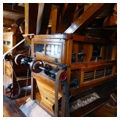You are here
McPherson County Old Mill Museum
The Smoky Valley Roller Mill is the best remaining example of the development of early flour milling technology in Kansas. The mill began as a primitive, small-scale, water-powered gristmill and evolved into a remarkably sophisticated early exemplar of automated roller mills. Mills of this type were developed to process the hard red winter wheat that was introduced in Kansas in the late nineteenth century and helped turn the state into America’s breadbasket.
The mill is a simple rectangular brick building on a rough limestone foundation. Measuring 32 x 46 feet, it has three stories plus a basement, making it 50 feet high. The interior floors and low-sloped gable roof are framed and decked in wood. A one-story appendage on the building’s southwestern side accommodated a small sales office. A separate one-story brick building that once held the power generating equipment sits to the south of the main building. A large, one-story makeshift shed to the northeast of the mill houses a museum that displays a wide array of objects from household items to stuffed animals. Access to the mill is now gained by going through the museum.
The interior of the mill is filled with a fascinating array of machinery. The moving parts are metal, the bases and grain chutes are wood, and the drive belts are leather. When the mill is in operation, trucks dump the grain into a chute to the basement. An auger then lifts the grain up to the top level where impurities and foreign objects are removed. The grain is then dampened and dropped back to the first floor where it goes through two pairs of corrugated rollers that break the wheat down into flour. The flour is then raised to the top floor where it is separated by size, and freed from impurities. The flour drops down into holding bins on the second floor, and finally into machines on the first floor that pack it into bags. Other machines capture any airborne dust that could cause an explosion. Even when the machines are still, one can sense the terrifying potential of the machines at work.
A prior mill had been erected on the site of the Smoky Valley Roller Mill in 1872, when Charles Johnson built a stone dam across the Smoky Hill River and a small wooden grist mill on the river’s northern bank in the southeastern corner of Lindsborg. The mill used waterpower to turn grinding stones. In 1882, J. G. Bergsten bought the mill and replaced the grinding stones with more powerful cold iron rollers; he also renamed the facility the Smoky Valley Roller Mill. The new machinery was more effective in processing the hard red winter wheat that had become the grain of choice for Kansan farmers. After operating the mill for seven years, Bergsten sold the mill to Theodore Teichgraeber.
When the original mill burned in 1898, Teichgraeber built the current structure and installed a remarkably sophisticated multi-step processing system that allowed wheat to be ground into flour in a seamless, fully automated operation that began with truckloads of grain being dumped into holding areas beneath the mill and culminated in flour bagged and ready for sale. The mill was able to produce 125 bushels of flour each day. Teichgraeber also built a distribution network that allowed his flour to be sold across the United States and in Europe.
When Teichgraeber died in 1907, his sons-in-law, William and Emanuel Hagstrom, took over the operation of the mill. After twenty years, they sold it to the Runbeck brothers. When the dam across the Smoky Hill River washed out in 1930, the mill’s power source was converted to electricity. The Runbecks ran the mill until 1955, when they could no longer compete with newer, more efficient mills.
Several years later the mill and 15 acres were given to McPherson County. The mill sat vacant for a number of years until 1974, when the Smoky Hill Historical Association took on the project of restoring it. Restoration was completed in 1981, making the mill operational once again. It is now open to the public and the mill machinery is operated one day each year.
References
Kansas Sampler Foundation. “8 Winders of Kansas Guidebook.” Newton, KS: Mennonite Press Inc., 2011.
Pankratz, Richard, “Smoky Valley Roller Mill,” McPherson County, Kansas. National Register of Historic Places Inventory-Nomination Form, 1972. National Park Service, U.S. Department of the Interior, Washington, D.C.
Wallen, Rose Marie, “Teichgraeber-Runbeck House,” McPherson County, Kansas. National Register of Historic Places Inventory-Nomination Form, 1973. National Park Service, U.S. Department of the Interior, Washington, D.C.
Writing Credits
If SAH Archipedia has been useful to you, please consider supporting it.
SAH Archipedia tells the story of the United States through its buildings, landscapes, and cities. This freely available resource empowers the public with authoritative knowledge that deepens their understanding and appreciation of the built environment. But the Society of Architectural Historians, which created SAH Archipedia with University of Virginia Press, needs your support to maintain the high-caliber research, writing, photography, cartography, editing, design, and programming that make SAH Archipedia a trusted online resource available to all who value the history of place, heritage tourism, and learning.


